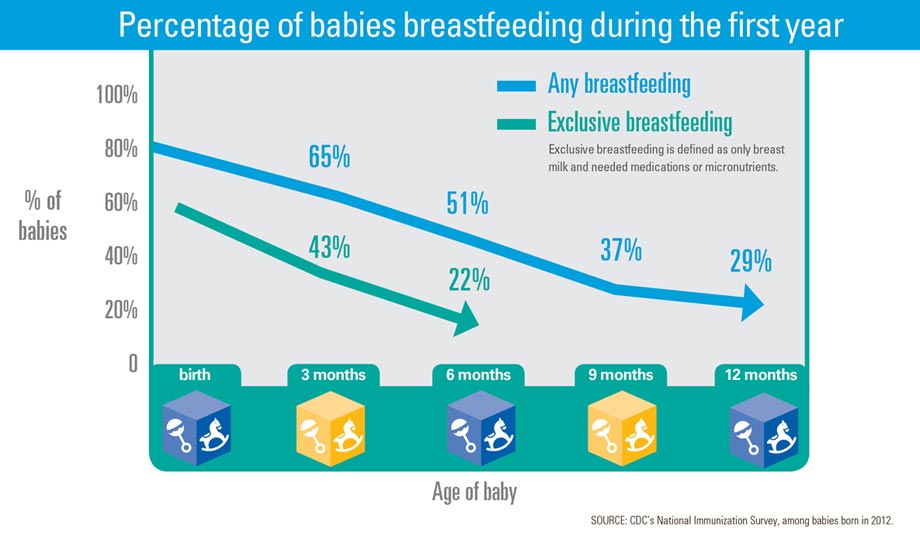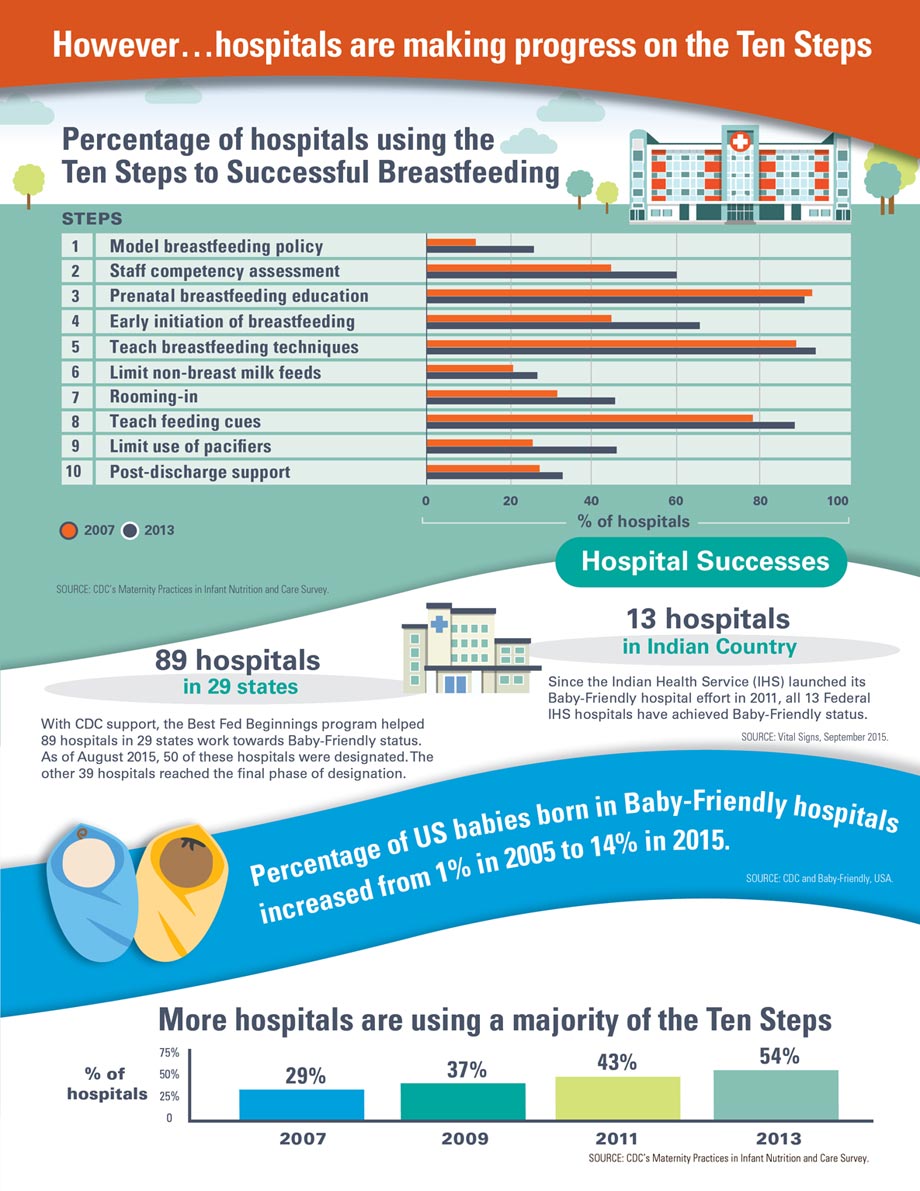Hospital Actions Affect Breastfeeding
Overview
Hospital practices in the first hours and days after birth make the difference in whether and how long babies are breastfed. The WHO/UNICEF Baby-Friendly Hospital Initiative is the global standard for hospital care to support breastfeeding, with the Ten Steps to Successful Breastfeeding at its core.
The percentage of US hospitals implementing a majority of the Ten Steps increased from about 29% in 2007 to nearly 54% in 2013. However, of approximately 3,300 maternity hospitals in the US, only 289 are designated Baby-Friendly. Hospitals influence how the nearly 4 million US babies born each year are fed. Further improvement in hospital practices could increase breastfeeding rates and contribute to better child health.
Hospitals can:
- Implement the Ten Steps to Successful Breastfeeding and work towards achieving Baby-Friendly designation.
- Use CDC’s Maternity Practices in Infant Nutrition and Care (mPINC) survey customized reports to improve maternity care practices that support breastfeeding.
- Work with doctors, nurses, lactation care providers, and organizations to create networks that provide clinic-based, at-home, or community breastfeeding support for mothers.

80% of babies born in the US start out breastfeeding.
6 in 10 breastfeeding mothers stop breastfeeding earlier than they intend.
14% of US babies are born in hospitals designated Baby-Friendly.
Practices in many US hospitals do not fully support breastfeeding.
Some of the Ten Steps on which hospitals fell shortest in 2013 included:
- Just 26% of hospitals had a model breastfeeding policy (Step 1).
- Only 26% of hospitals did not routinely feed formula to healthy, breastfed infants when there was no medical reason to do so (Step 6).
- Less than half (45%) of hospitals kept mothers and babies together throughout the entire hospital stay, which provides opportunities to breastfeed and helps mothers learn feeding cues (Step 7).
- Just 32% of hospitals provided enough support for breastfeeding mothers when they left the hospital (Step 10).
Not enough babies are breastfeeding as recommended:
- Only 22% of babies are exclusively breastfed for 6 months as recommended.
- Only 29% are breastfed for 12 months as recommended.
- Babies who are breastfed have reduced risks of ear and respiratory infections, asthma, sudden infant death syndrome (SIDS), diabetes, and obesity.

The Federal government is
- Helping hospitals become designated as Baby-Friendly through funding and technical assistance.
- Supporting state health departments to help hospitals improve maternity care practices.
- Tracking hospital policies and practices that support breastfeeding using CDC’s Maternity Practices in Infant Nutrition and Care (mPINC) survey to evaluate federal, state and local efforts.
- Making breastfeeding counseling and supplies available to families with no out-of-pocket cost through a health insurance plan provision of the Affordable Care Act.
States and local government can
- Adopt standards for hospitals to support breastfeeding.
- Help hospitals implement the Ten Steps to Successful Breastfeeding.
- Help hospitals connect mothers to community programs for support once they leave the hospital.
Hospitals can
- Implement the Ten Steps to Successful Breastfeeding and work towards achieving
Baby-Friendly designation. - Use CDC’s Maternity Practices in Infant Nutrition and Care (mPINC) survey customized reports to improve maternity care practices that support breastfeeding.
- Work with doctors, nurses, lactation care providers, and organizations to create networks that provide clinic-based, at-home, or community breastfeeding support for mothers.
Healthcare providers can
- Help write hospital policies that support mothers and babies to breastfeed.
- Counsel mothers on breastfeeding during prenatal visits.
- Include lactation care providers and other breastfeeding experts on patient care teams.
- Support breastfeeding in the hospital and at well-baby visits.
Mothers and their families can
- Talk to their healthcare providers about breastfeeding plans, and ask about how to get help with breastfeeding.
- Ask about breastfeeding support practices and Baby-Friendly designation when choosing a maternity hospital.
- Join with other community members to encourage local hospitals to improve breastfeeding support and become Baby-Friendly. Top of Page
Issue Details
Related Pages
- Vital Signs Issue details: Improvements in Maternity Care Policies and Practices That Support Breastfeeding — United States, 2007–2013, Morbidity and Mortality Weekly Report (MMWR)
- Vital Signs – Hospital Actions Affect Breastfeeding [PODCAST – 1:15 minutes]
- Vital Signs – Hospital Actions Affect Breastfeeding [PSA – 0:60 seconds]
- CDC breastfeeding
- CDC’s mPINC Survey
- Rates of breastfeeding nationally and by state (National Immunization Survey)
- DNPAO’s Data, Trends and Maps database

